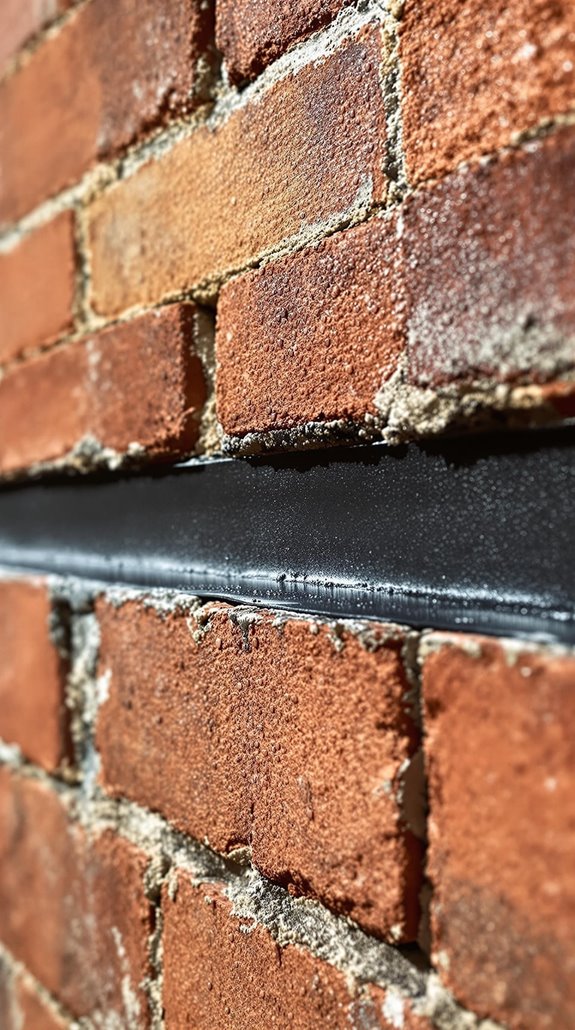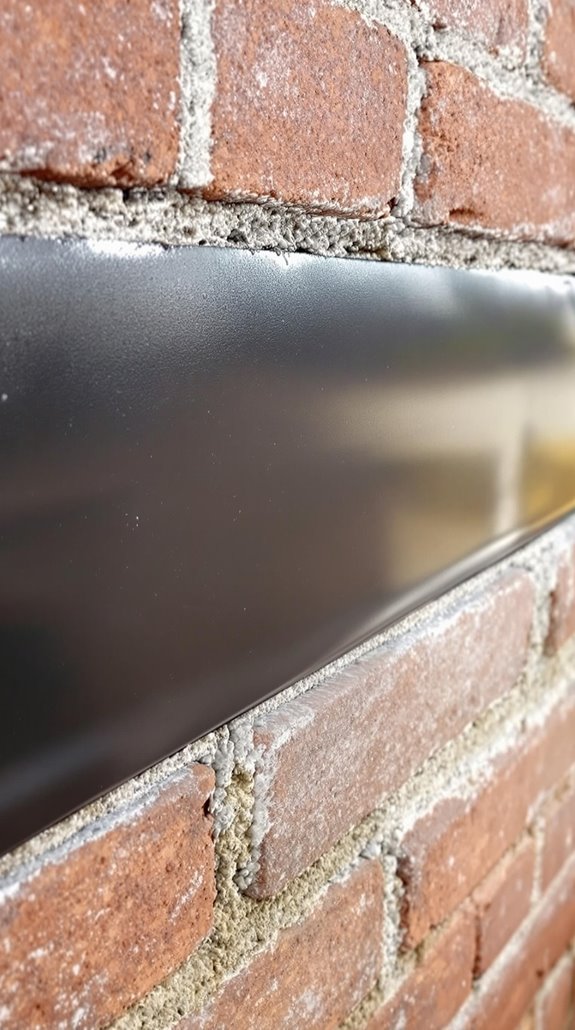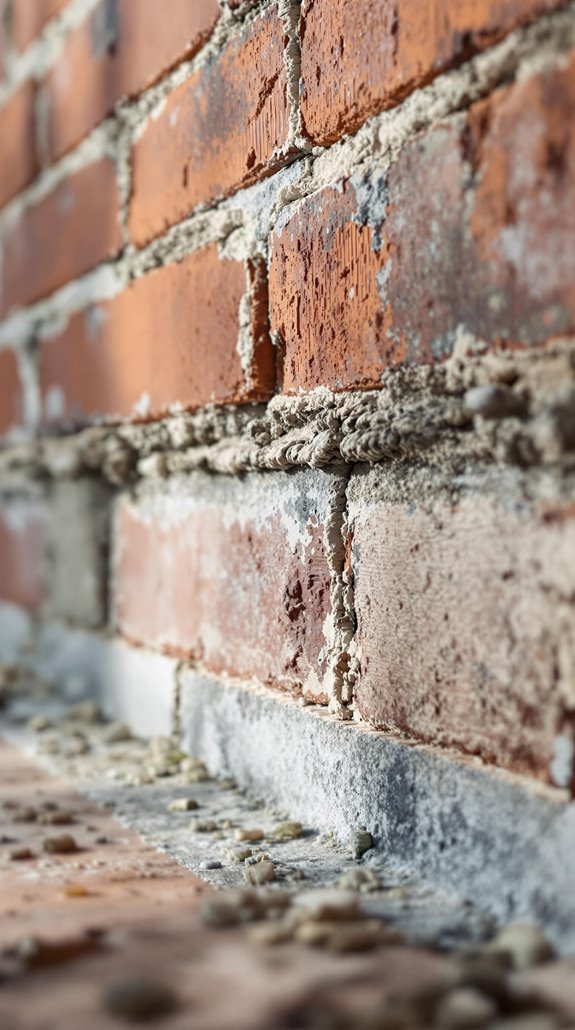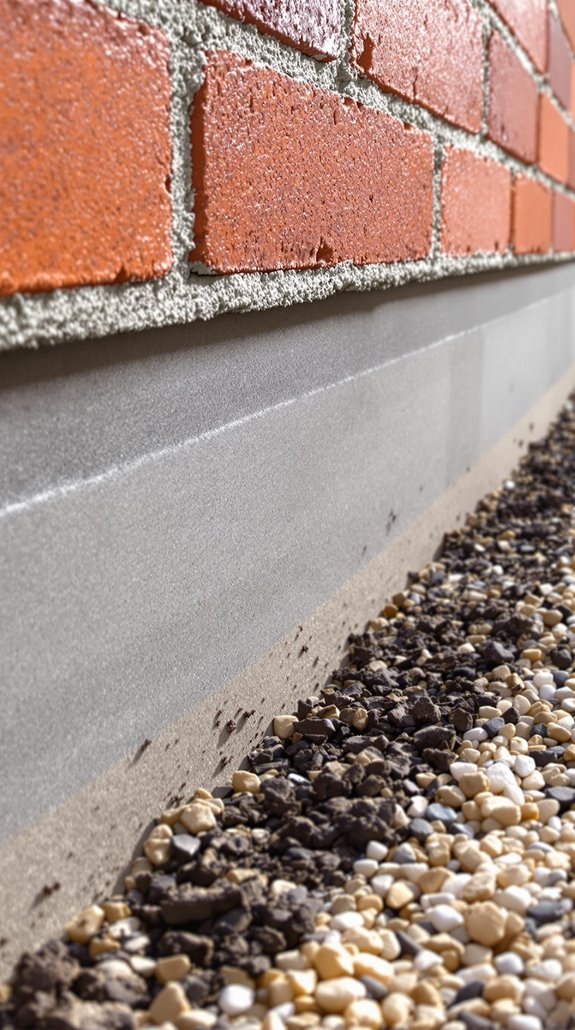I’ll explain what a damp proof course is and why it’s essential for protecting your UK home from costly moisture damage. A DPC is a horizontal barrier installed in your walls to prevent rising damp from ground water, and if you’re experiencing peeling paint, musty odors, or deteriorating plaster, your DPC might be failing. Understanding these warning signs and knowing when to take action can save you thousands in structural repairs and protect your family’s health.
Key Takeaways
- A Damp Proof Course (DPC) is a moisture barrier that prevents rising damp from groundwater entering your home’s walls.
- UK Building Regulations Part C requires DPC installation at least 150mm above ground level for all new constructions.
- Common DPC materials include bitumen, polyethylene, and metal sheeting, installed following BS 8215 standards for effective protection.
- Signs of DPC failure include damp patches, salt deposits, musty odors, and peeling paint within one meter of walls.
- Professional assessment uses moisture meters and thermal imaging, with repair options including chemical injection and membrane systems.
Understanding Damp Proof Course: Definition and Core Purpose

When moisture infiltrates your building’s structure through capillary action, it’s creating a pathway for extensive damage that can compromise both the integrity of your property and the health of its occupants. I’ll explain how a Damp Proof Course (DPC) serves as your first line of defense against this threat.
A DPC is fundamentally a barrier designed to prevent moisture infiltration through capillary action – the process where groundwater rises through masonry materials. This protective layer blocks water movement in walls, floors, and roofs, specifically targeting rising damp caused by groundwater ascent.
The primary function is straightforward: halt capillary rise before it causes structural damage like crumbling plaster, timber warping, or creates health hazards through mold growth that affects your family’s wellbeing. Additionally, an effective DPC system reduces the breeding of mosquitoes and termites that thrive in damp environments, creating a healthier living space for your household.
Legal Requirements and Building Regulations for UK Properties
Building Regulations Part C doesn’t just recommend damp proof courses—it mandates them for all new UK constructions to prevent rising damp and moisture damage that can compromise your property’s structural integrity.
I’ll help you navigate these requirements. You’ll need planning permission for major renovations, extensions, or basement projects that alter your DPC. However, smaller repairs often qualify as permitted development. Commercial properties face stricter criteria, requiring moisture-resistant floors and walls.
Your local Building Control office must verify compliance before work begins. They’ll inspect DPC continuity, correct height positioning, and integration with membranes. The DPC must be positioned a minimum 150mm above the adjoining ground level to meet current standards. Non-compliance isn’t worth the risk—you’re facing potential enforcement action, structural damage, and health issues from mould growth.
Always consult Building Control for project-specific verification.
Materials and Installation Methods for Effective Damp Protection

Since proper material selection determines your DPC’s long-term effectiveness against moisture intrusion, you’ll need to understand which materials suit your specific construction requirements. Bitumen offers flexible, traditional protection for standard brick construction, while polyethylene provides excellent chemical resistance for residential use. Metal sheeting like lead or copper handles high structural loads effectively, and slate works perfectly for heritage buildings requiring compressive strength.
For installation, you’ll measure and cut materials to required lengths, then place your DPC horizontally at 150mm above ground level. Bed it in fresh mortar without gaps, overlapping joints by 100mm minimum. When installing DPMs, prepare surfaces properly, overlap sheets by 300mm, and integrate seamlessly with your DPC. Following BS 8215 standards guarantees compliance while preventing rising damp effectively. Quality DPC systems also prevent water transfer around door sills and window jambs, protecting these vulnerable entry points from moisture penetration.
Recognizing Signs of DPC Failure in Your Home
How can you tell if your damp proof course has failed and requires immediate attention? I’ll help you identify the telltale signs that indicate your DPC isn’t protecting your home effectively.
Look for damp patches within the bottom metre of your walls, particularly around skirting boards where tide marks often appear. You’ll notice salt deposits forming white crystalline patches on surfaces, while paint and wallpaper start peeling or bubbling from moisture absorption. The musty, earthy smell is unmistakable when moisture becomes trapped within walls.
Check for warping timber skirting boards and crumbling plaster caused by recrystallizing salts. Cold spots on walls and increased condensation on nearby windows signal ongoing moisture problems. A failing DPC can also compromise your home’s structural integrity as moisture weakens the foundation and supporting elements over time. Don’t confuse these symptoms with condensation or penetrating damp – rising damp creates distinctive horizontal patterns that persist despite dry weather conditions.
Health and Structural Risks of Inadequate Damp Proofing

When your damp proof course fails, it doesn’t just create unsightly stains—it poses serious threats to both your family’s health and your property’s structural integrity.
I’ve seen firsthand how rising damp creates perfect conditions for mould growth, triggering respiratory problems like asthma, coughing, and wheezing. Your family may experience skin irritation, allergic reactions, and even mental health impacts from living in persistently damp conditions. These harmful microorganisms thrive in damp environments and can lead to prolonged exposure risks that affect your entire household.
Structurally, the damage is equally concerning. Moisture penetrates your walls, causing bricks and mortar to deteriorate while wooden elements begin rotting. Your floors can become unstable, and wall plaster starts cracking and peeling.
Without proper damp proofing, you’re facing expensive repairs and potential devaluation of your property. The DPC prevents ground moisture from rising through your walls, protecting both your investment and your family’s wellbeing.
Retrofit Solutions for Older Properties Without DPC
Older properties built before 1875 rarely included proper damp proof courses, leaving you with rising damp problems that require careful retrofit solutions. I’ll guide you through proven methods that preserve your home’s character while solving moisture issues effectively.
Chemical DPC injection offers the least disruptive approach. You’ll inject silicone-based formulas into drilled mortar holes, creating a water-repellent barrier 150mm above ground level. For stone walls, I recommend tailoring chemical viscosity to match your masonry’s density. Proper insulation can also help reduce the risk of damp issues by improving thermal efficiency and minimizing condensation.
Physical insertion works when you’re already repointing. You can embed polymer membranes or install slate DPCs in lime mortar joints for pre-1900 buildings requiring historical accuracy.
Before any DPC installation, you must address defects first. Repair roof leaks, re-point deteriorated mortar using NHL 3.5 lime, and guarantee proper drainage around your property’s perimeter. Properties with solid walls require breathability to manage moisture effectively, making material selection crucial for preventing trapped moisture that can worsen damp issues over time. Investing in home insulation can significantly enhance your property’s overall performance and comfort.
Maintenance and Ground Level Management Best Practices

Since your damp proof course is only as effective as the conditions surrounding it, I’ll show you maintenance practices that prevent moisture problems before they start.
First, I’ll guarantee ground levels stay 150mm below your DPC height. When soil builds up, I dig it out immediately—this prevents water from bypassing your protection entirely.
Next, I maintain proper drainage by cleaning gutters quarterly and positioning downspouts 1.5m from foundations. Water pooling against walls will find every weakness.
I conduct annual inspections, checking for cracks and monitoring membrane continuity. When I spot damp patches, I address them within 48 hours—delays cost more later.
Finally, I keep vegetation 2m from walls and replace moisture-heavy plants with gravel borders. I also ensure proper ground slopes away from the property to divert rainwater effectively. These simple steps protect your investment year-round.
Professional Assessment and Repair Options
Even the best maintenance practices can’t fix an existing damp proof course that’s already failed or was never properly installed. When you’re facing persistent dampness, I recommend getting professional assessment using moisture meters and thermal imaging cameras to identify hidden problems you can’t see. A thorough inspection can help detect subsidence issues that may exacerbate damp conditions.
Your repair options depend on your specific situation. Chemical DPCs involve injecting silicone-based liquids 150mm above base level, while membrane systems create physical barriers under concrete slabs. For severe cases, you might need combination approaches like chemical injection plus waterproof tanking.
Don’t tackle this alone – professional installers guarantee continuous barriers with proper 100mm overlaps at joints. They’ll also handle specialized methods like electro-osmotic systems that reverse moisture rise through electrical charge treatment, giving you lasting protection. Properties built before the 1950s are particularly vulnerable as they may completely lack effective damp proof courses.
Compliance Standards and Building Control Requirements
While professional installation guarantees proper technique, your damp proof course must also meet strict building regulations that govern everything from material specifications to installation heights. Under Approved Document C, I need to ascertain your DPC extends at least 150mm above ground level and integrates seamlessly with floor membranes. The Building Safety Act 2022 empowers regulators to enforce these standards rigorously.
Your materials must demonstrate water impermeability through third-party certification like BBA Agrément. Building Control Officers will inspect during construction phases, requiring documentation of specifications and installation methods. Non-compliance triggers enforcement notices under the Building Act 1984. For retrofit projects, I’ll arrange before-and-after damp audits and post-installation moisture mapping to verify regulatory compliance and protect your investment.
These standards apply equally to existing structures undergoing renovations where modifications affect the building’s moisture management systems.
Documentation and Warranty Considerations for Homeowners
Meeting regulatory standards represents just one aspect of protecting your damp proof course investment. I’ll guide you through essential documentation that safeguards your property’s future.
Your damp proof certificate serves as official confirmation that qualified contractors have completed compliant work. This document verifies proper diagnosis of damp causes and installation of approved materials. It’s your primary defense against future disputes and supports insurance claims when moisture issues arise.
I recommend storing certificates both physically and digitally for permanent access. During property sales, include them in disclosure packs to enhance marketability and satisfy lender requirements. The certificate acts as contractor assurance, typically covering 10-30 years of protection.
Always verify transferability clauses and retain contractor details for potential warranty claims throughout the certificate’s lifespan. Remember that remedial work may also require plaster replacement to a height of 1 m following DPC installation to ensure complete moisture protection.
Conclusion
I’ve covered the essential aspects of DPC systems that’ll protect your UK home from rising damp. You now understand the legal requirements, installation methods, and warning signs of failure. Don’t ignore moisture problems—they’ll only worsen and cost more to fix. I recommend scheduling regular inspections, maintaining proper ground levels, and consulting qualified professionals when issues arise. Your home’s structural integrity and your family’s health depend on effective damp proofing.
References
- https://www.atlantisdamp.co.uk/blog/what-is-a-damp-proof-course/
- https://thecivilengineering.com/damp-proof-course/
- https://www.designingbuildings.co.uk/wiki/Damp_proof_course
- https://www.homebuilding.co.uk/advice/damp-proof-courses
- https://www.southerndampproofing.co.uk/damp-proofing/rising-penetrating-damp/what-is-a-damp-proof-course/
- https://www.allweathercoating.co.uk/blog/damp-proof-course/
- https://watertight-homes.co.uk/what-is-a-damp-proof-course/
- https://www.jtdbuildingsupplies.co.uk/blog/the-importance-of-damp-proofing-in-construction/
- https://www.travisperkins.co.uk/content/building-regulations/part-c
- https://www.fixfirm.com/blog/view/new-dpc-regulations-what-you-need-to-know

